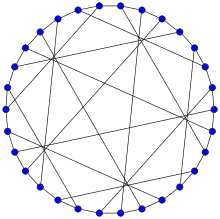Cage (graph theory)

In the mathematical area of graph theory, a cage is a regular graph that has as few vertices as possible for its girth.
Formally, an (r,g)-graph is defined to be a graph in which each vertex has exactly r neighbors, and in which the shortest cycle has length exactly g. It is known that an (r,g)-graph exists for any combination of r ≥ 2 and g ≥ 3. An (r,g)-cage is an (r,g)-graph with the fewest possible number of vertices, among all (r,g)-graphs.
If a Moore graph exists with degree r and girth g, it must be a cage. Moreover, the bounds on the sizes of Moore graphs generalize to cages: any cage with odd girth g must have at least
vertices, and any cage with even girth g must have at least
vertices. Any (r,g)-graph with exactly this many vertices is by definition a Moore graph and therefore automatically a cage.
There may exist multiple cages for a given combination of r and g. For instance there are three nonisomorphic (3,10)-cages, each with 70 vertices : the Balaban 10-cage, the Harries graph and the Harries–Wong graph. But there is only one (3,11)-cage : the Balaban 11-cage (with 112 vertices).
Known cages
A degree-one graph has no cycle, and a connected degree-two graph has girth equal to its number of vertices, so cages are only of interest for r ≥ 3. The (r,3)-cage is a complete graph Kr+1 on r+1 vertices, and the (r,4)-cage is a complete bipartite graph Kr,r on 2r vertices.
Other notable cages include the Moore graphs:
- (3,5)-cage: the Petersen graph, 10 vertices
- (3,6)-cage: the Heawood graph, 14 vertices
- (3,8)-cage: the Tutte–Coxeter graph, 30 vertices
- (3,10)-cage: the Balaban 10-cage, 70 vertices
- (3,11)-cage: the Balaban 11-cage, 112 vertices
- (4,5)-cage: the Robertson graph, 19 vertices
- (7,5)-cage: The Hoffman–Singleton graph, 50 vertices.
- When r − 1 is a prime power, the (r,6) cages are the incidence graphs of projective planes.
- When r − 1 is a prime power, the (r,8) and (r,12) cages are generalized polygons.
The numbers of vertices in the known (r,g) cages, for values of r > 2 and g > 2, other than projective planes and generalized polygons, are:
g r | 3 | 4 | 5 | 6 | 7 | 8 | 9 | 10 | 11 | 12 |
|---|---|---|---|---|---|---|---|---|---|---|
| 3 | 4 | 6 | 10 | 14 | 24 | 30 | 58 | 70 | 112 | 126 |
| 4 | 5 | 8 | 19 | 26 | 67 | 80 | 728 | |||
| 5 | 6 | 10 | 30 | 42 | 170 | 2730 | ||||
| 6 | 7 | 12 | 40 | 62 | 312 | 7812 | ||||
| 7 | 8 | 14 | 50 | 90 |
Asymptotics
For large values of g, the Moore bound implies that the number n of vertices must grow at least singly exponentially as a function of g. Equivalently, g can be at most proportional to the logarithm of n. More precisely,
It is believed that this bound is tight or close to tight (Bollobás & Szemerédi 2002). The best known lower bounds on g are also logarithmic, but with a smaller constant factor (implying that n grows singly exponentially but at a higher rate than the Moore bound). Specifically, the Ramanujan graphs (Lubotzky, Phillips & Sarnak 1988) satisfy the bound
It is unlikely that these graphs are themselves cages, but their existence gives an upper bound to the number of vertices needed in a cage.
References
- Biggs, Norman (1993), Algebraic Graph Theory (2nd ed.), Cambridge Mathematical Library, pp. 180–190, ISBN 0-521-45897-8.
- Bollobás, Béla; Szemerédi, Endre (2002), "Girth of sparse graphs", Journal of Graph Theory, 39 (3): 194–200, doi:10.1002/jgt.10023, MR 1883596.
- Exoo, G; Jajcay, R (2008), "Dynamic Cage Survey", Dynamic Surveys, Electronic Journal of Combinatorics, DS16.
- Erdős, Paul; Rényi, Alfréd; Sós, Vera T. (1966), "On a problem of graph theory" (PDF), Studia Sci. Math. Hungar., 1: 215–235.
- Hartsfield, Nora; Ringel, Gerhard (1990), Pearls in Graph Theory: A Comprehensive Introduction, Academic Press, pp. 77–81, ISBN 0-12-328552-6.
- Holton, D. A.; Sheehan, J. (1993), The Petersen Graph, Cambridge University Press, pp. 183–213, ISBN 0-521-43594-3.
- Lubotzky, A.; Phillips, R.; Sarnak, P. (1988), "Ramanujan graphs", Combinatorica, 8 (3): 261–277, doi:10.1007/BF02126799, MR 963118.
- Tutte, W. T. (1947), "A family of cubical graphs", Proc. Cambridge Philos. Soc., 43 (4): 459–474, doi:10.1017/S0305004100023720.
External links
- Brouwer, Andries E. Cages
- Royle, Gordon. Cubic Cages and Higher valency cages
- Weisstein, Eric W. "Cage Graph". MathWorld.